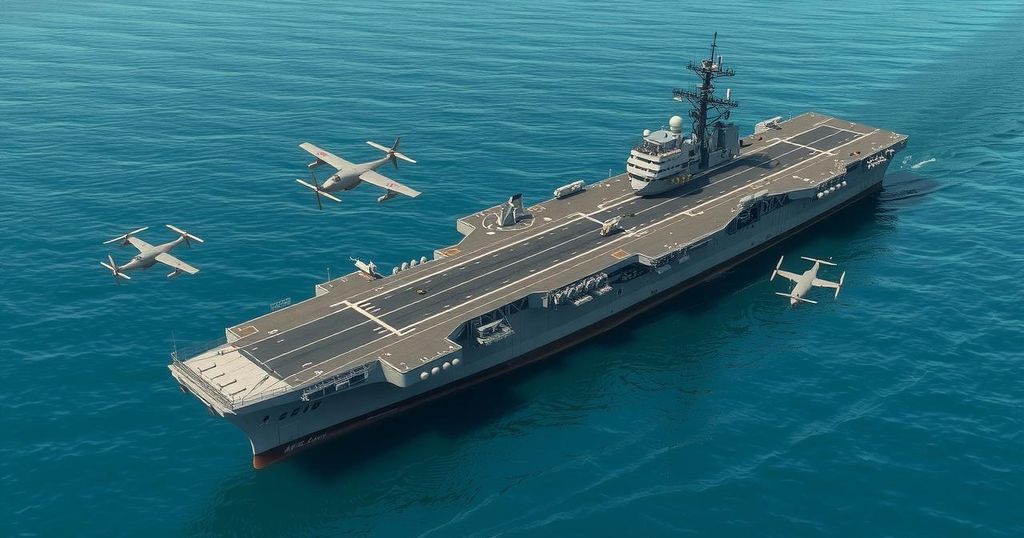Indonesia Considers Acquisition of Italy’s Giuseppe Garibaldi Aircraft Carrier
Indonesia is contemplating the acquisition of Italy’s decommissioned aircraft carrier Giuseppe Garibaldi for naval drone operations, as part of a broader defense strategy to enhance its maritime capabilities through local production of drones and collaboration with Turkey. The ship has a notable operational history and potential modifications could align with Indonesia’s military objectives and regional security needs.
On March 11, 2025, it was reported by Rivista Italiana Difesa (RID) that Indonesia is exploring the potential acquisition of the decommissioned Italian aircraft carrier Giuseppe Garibaldi. This acquisition is being contemplated to enhance Indonesia’s naval capabilities, particularly in the deployment of drones, in conjunction with a partnership established with Turkish company Baykar to produce navalized TB-3 drones and Akinci UAVs domestically.
Originally commissioned in 1985, the Giuseppe Garibaldi served as an anti-submarine warfare carrier and was notable as Italy’s first ship featuring a full-length flight deck. Over its operational history, the ship transitioned from helicopter-only operations to accommodate fixed-wing aircraft following legislative changes, and has undergone significant upgrades to enhance its combat capabilities.
The vessel has a standard displacement of 10,100 tons and a full-load displacement of 14,150 tons after modifications. Its design includes a flight deck equipped for short take-off and vertical landing (STOVL) aircraft, enhancing operational capacity. The vessel is powered by four General Electric/Avio LM2500 gas turbines, allowing for speeds exceeding 30 knots with an operational range of around 7,000 nautical miles.
Equipped with advanced electronic systems, the Garibaldi includes multiple radars for air and surface detection, electronic warfare systems, and surface-to-air missile launchers. The ship typically carries Harrier II aircraft and helicopters for various military missions, showcasing its versatility and operational efficacy throughout its history, including participation in significant NATO operations.
The potential acquisition aligns with Indonesia’s Minimum Essential Force (MEF) strategy which emphasizes enhancing naval assets. The Chief of Staff of the Indonesian Navy, Admiral Muhammad Ali, has expressed the intent to secure an aircraft carrier among other naval assets to fortify the country’s maritime defense capabilities. This development is reinforced by parliamentary approval for additional naval patrol vessels within Indonesia’s expanding fleet.
The envisioned role of the Garibaldi within the Indonesian Navy may include conversion into a drone carrier, following an agreement with Baykar for the local production of TB-3 drones. Indonesia also has historical ties with Italy in defense procurement, highlighted by recent acquisitions of former Italian Navy vessels.
Should negotiations progress, the deal may encompass the transfer of additional AV-8B Harrier II aircraft. Notably, there are alternative proposals being evaluated regarding domestic construction capabilities, potentially in collaboration with foreign industries, aimed at better aligning Indonesia’s naval strategy with its budgetary constraints and security requirements in the South China Sea region.
Indonesia’s ongoing naval expansion is crucial for addressing regional security challenges, particularly with territorial integrity concerns in the Natuna Islands. The strategic enhancement of its fleet is essential for maintaining rapid-response capabilities across its vast archipelago, signifying a focus on modernizing maritime defense assets in line with evolving geopolitical dynamics.
Indonesia’s exploration of acquiring the Giuseppe Garibaldi aircraft carrier highlights its ongoing commitment to modernizing its naval capabilities and enhancing defense cooperation with Italy and Turkey. The ship’s potential transformation into a drone carrier aligns with Indonesia’s strategic objectives outlined in its Minimum Essential Force plan. However, financial and logistical considerations will significantly influence the feasibility of such an acquisition amidst the evolving security landscape, particularly in the South China Sea.
Original Source: armyrecognition.com




Post Comment